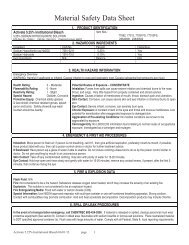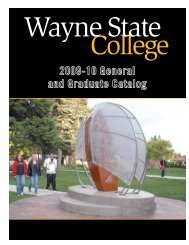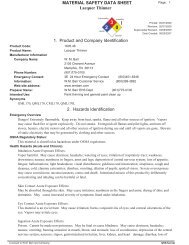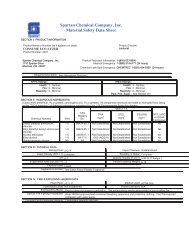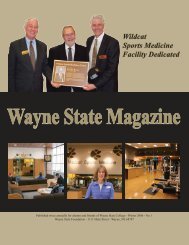Paint Thinner MSDS - Case School of Engineering
Paint Thinner MSDS - Case School of Engineering
Paint Thinner MSDS - Case School of Engineering
You also want an ePaper? Increase the reach of your titles
YUMPU automatically turns print PDFs into web optimized ePapers that Google loves.
MATERIAL SAFETY DATA SHEET<br />
<strong>Paint</strong> <strong>Thinner</strong><br />
8. Exposure Controls/Personal Protection<br />
Page:<br />
Printed: 12/31/2008<br />
Revision: 11/13/2008<br />
Supercedes Revision: 09/25/2008<br />
Respiratory Equipment (Specify Type)<br />
For OSHA controlled work place and other regular users. Use only with adequate ventilation under engineered<br />
air control systems designed to prevent exceeding appropriate TLV. For occasional use, where engineered air<br />
control is not feasible, use properly maintained and properly fitted NIOSH approved respirator for organic solvent<br />
vapors. A dust mask does not provide protection against vapors.<br />
Eye Protection<br />
Safety glasses, goggles or face shields are recommended to safeguard against potential eye contact, irritation, or<br />
injury. Contact lenses should not be worn while working with chemicals.<br />
Protective Gloves<br />
Wear impermeable gloves. Gloves contaminated with product should be discarded. Promptly remove clothing<br />
that becomes soiled with product.<br />
Other Protective Clothing<br />
Various application methods can dictate use <strong>of</strong> additional protective safety equipment, such as impermeable<br />
aprons, etc., to minimize exposure. Before reuse, thoroughly clean any clothing or protective equipment that has<br />
been contaminated by prior use. Discard any clothing or other protective equipment that cannot be<br />
decontaminated, such as gloves or shoes.<br />
<strong>Engineering</strong> Controls (Ventilation etc.)<br />
Use only with adequate ventilation to prevent build-up <strong>of</strong> vapors. Open all windows and doors. Use only with a<br />
cross ventilation <strong>of</strong> moving fresh air across the work area. If strong odor is noticed or you experience slight<br />
dizziness, headache, nausea, or eye-watering - Stop - ventilation is inadequate. Leave area immediately.<br />
Work/Hygienic/Maintenance Practices<br />
A source <strong>of</strong> clean water should be available in the work area for flushing eyes and skin.<br />
Do not eat, drink, or smoke in the work area.<br />
Wash hands thoroughly after use.<br />
9. Physical and Chemical Properties<br />
Physical States: [ ] Gas [ X ] Liquid [ ] Solid<br />
Melting Point:<br />
No data.<br />
Boiling Point:<br />
298.00 F - 400.00 F<br />
Autoignition Pt:<br />
446.00 F<br />
Flash Pt: >= 101.00 F Method Used: Setaflash Closed Cup (Rapid Setaflash)<br />
Explosive Limits: LEL: ~ 0.5 % UEL: ~ 6 %<br />
Specific Gravity (Water = 1): 0.78<br />
Vapor Pressure (vs. Air or mm Hg): 0.22 MM HG at 68.0 F<br />
Vapor Density (vs. Air = 1): 4.7<br />
Evaporation Rate (vs Butyl No data.<br />
Acetate=1):<br />
Solubility in Water:<br />
No data.<br />
Solubility Notes<br />
Very slightly soluble in cold water.<br />
Percent Volatile:<br />
100.0 % by weight.<br />
VOC / Volume:<br />
784.0000 G/L<br />
Corrosion Rate:<br />
No data.<br />
pH:<br />
No data.<br />
Appearance and Odor<br />
Water White / Free and Clear<br />
4<br />
Licensed to W.M. Barr and Company<br />
ANSI Z400.1 Format



